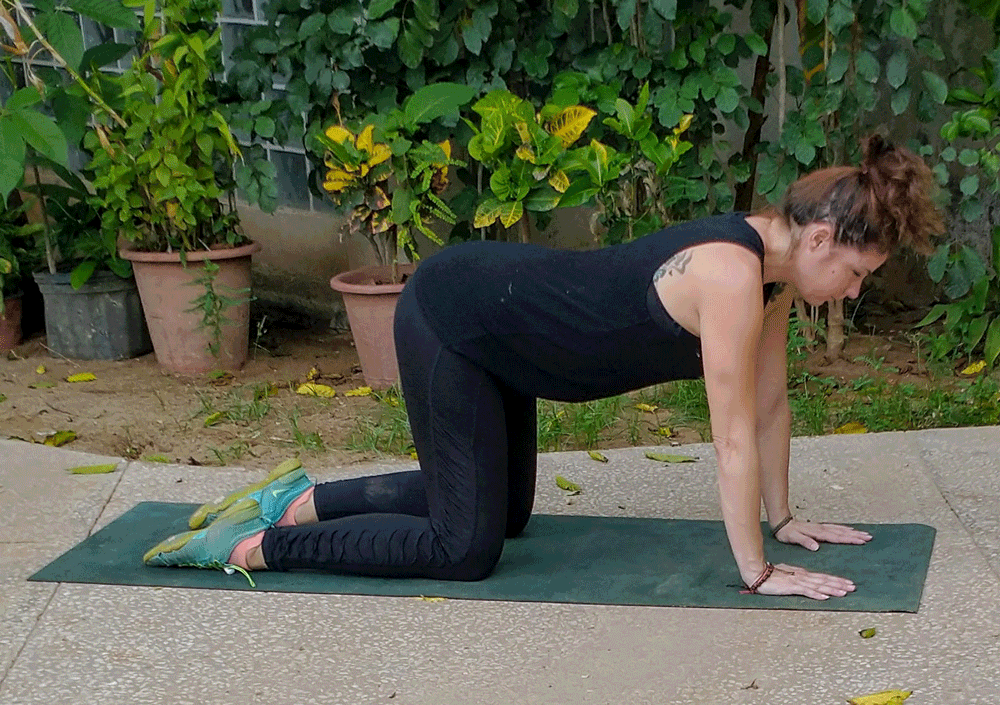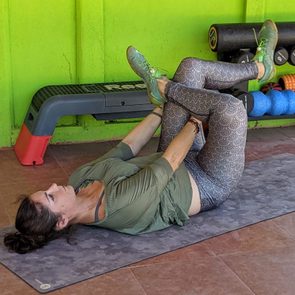How to Do a Cat-Cow Stretch to Help Your Back and Prevent Pain
Updated: Jun. 10, 2021
Work on total spine mobility with the cat-cow stretch, a super-easy yoga pose. Learn how to do it correctly and which common mistakes to avoid.
The importance of spinal mobility
All day long, you rely on your spine to flex, extend, and rotate. This long column caters to every moment-to-moment movement need you might have.
But how often do you slow down and really take the time to move your spine through a controlled rounding and arching of your back, consciously trying to move each vertebra independently?
If you’re like most people, probably not very often. This is exactly why you should be adding a cat-cow stretch to your regular workout routine.
(Beware of the everyday habits that are damaging your spine.)
What is the cat-cow stretch?
“The cat-cow stretch is designed to mobilize and coordinate the spine through flexion and extension,” says Sergio Pedemonte, celebrity personal trainer and owner of Your House Fitness in Canada.
Flexion and extension are just fancy fitness words for the bending and extending of your back. In the cat-cow stretch, back flexion happens when you round your back like a black cat, and back extension happens when you arch your low back like a cow.
Benefits of the cat-cow stretch
This type of controlled mobilization is particularly important for the thoracic spine, which is located in the upper back. It has a tendency to become stiff and immobile due to sedentary lifestyles and extended bouts of sitting.
“It’s important to maintain flexibility in your upper back when promoting natural human movement,” Pedemonte says. “Often when people stay in one position for an extended period of time, their upper back loses flexibility and the neck or lower back will compensate, causing many imbalances in the body, which can lead to potential pain or injury.”
Essentially, the cat-cow is a gentle, easy yoga pose that helps maintain or improve spinal mobility.
While you may perform flexion regularly throughout your day (slouching, bending over, leaning forward, and so forth), chances are you spend less time extending your spine through a full range of motion.
“This movement focuses on spinal articulation with shoulder and hip stability,” says Cassandra Cotta, a Pilates instructor and creator of Pilates People. “It’s a great way to assess how your spine is feeling from day to day and to loosen up a stiff back.”
Because your shoulders and hips are stable as you perform the exercise and you match the movements to your breath, cat-cow requires core engagement and control.
Who should (and shouldn’t) try the cat cow stretch
The cat cow stretch is a beginner-friendly exercise that is generally safe for most people to perform. That said, there are always exceptions.
This exercise is performed on the hands and knees, so if you have wrist or knee pain or an injury, you may find the exercise uncomfortable. You can try to make modifications to alleviate discomfort.
For instance, Cotta suggests making fists before placing your hands on the floor with wrists straight. That way, you’ll be supporting your weight with your knuckles, not relying on a hyperextended, flat-palmed support.
Likewise, you can use rolled up towels or a yoga mat to help support your wrists and knees with additional padding.
When to do the cat-cow stretch
You may be tempted to add this movement to your morning routine as a way to loosen up a tight back. But it’s best not to do it first thing after you wake up.
“Stretching the spine after sleep can be a risk for injury, as the vertebral discs are relaxed and filled with more spinal fluid from extended lying positions,” Pedemonte explains. “When the spine is put through flexion and extension directly after sleep, the intervertebral discs have a higher chance of herniation.”
So wait until you’ve moved around and gone through some basic daily tasks (like showering, eating, and getting ready for work) before you make like a cat and cow.
(Ease hip pain with these moves.)

How to perform the cat-cow stretch
Start on your hands and knees on a mat, adding extra padding under your hands or knees if you feel you need it.
Check your body’s positioning. Your wrists should be in line with your shoulders, your elbows should be fully extended, and your knees should be lined up with your hips.
Begin with a neutral spine: engage your core and be sure your body makes a straight line from your tailbone to the top of your head. As you take a deep breath in, enter the cow pose.
Cow pose
Allow your belly to drop toward the floor as you lift your gaze up toward the ceiling. (Don’t crank your neck back!)
Move your tailbone so it points toward the ceiling, and extend your spine to move your chest forward.
When you’ve extended your spine as much as you comfortably can, hold for a beat.
As you exhale, begin moving into the cat pose.
Cat pose
Reverse the movement. This time, arch your back. Tuck your chin to your chest to look toward your belly.
As you move, draw your hips forward, tucking your pelvis under.
When you feel completely flexed, hold for a beat.
The cat-cow series
Continue moving into cow pose with each deep inhale and then into cat pose with each deep exhale.
Perform two sets of 10 to 15 rounds.
(Learn the difference between static vs. dynamic stretching.)
Tips for performing the cat-cow stretch
Even though this is a beginner-level stretch, errors are possible, so double check to make sure you’re not committing any of these common mistakes, often spotted by Lucile Hernandez Rodriguez, a 500-hour yoga teacher.
Pay attention to your neck
It’s a very common mistake to throw your head back to look up when entering cow pose, but doing so could strain your neck.
Likewise, when moving into cat pose, you shouldn’t force your head down between your arms or move with speed to drop your head down. Keep your neck motions slow, controlled, and unforced.
Move from your spine
Remember that movement in the cat-cow stretch is coming from the spine, not your arms, elbows, knees, or hips. Your arms, shoulders, knees, and hips are there to provide stabilization and support.
As such, keep them straight, steady, and immobile as your spine moves. Don’t try to help the pose by using another part of your body to deepen the stretch.
Pick the right time of day
You may be tempted to add this movement to your morning routine as a way to loosen up a tight back. But it’s best not to do it first thing after you wake up.
“Stretching the spine after sleep can be a risk for injury, as the vertebral discs are relaxed and filled with more spinal fluid from extended lying positions,” Pedemonte explains. “When the spine is put through flexion and extension directly after sleep, the intervertebral discs have a higher chance of herniation.”
So wait until you’ve moved around and gone through some basic daily tasks (like showering, eating, and getting ready for work) before you try it.
The cat-cow stretch makes for an excellent warm-up stretch and a good way to alleviate tension and stress at the end of your day. You can perform the move with or without performing other exercises.
Aside from first thing when you wake up, practically any time is a good time to make like a cat and cow.
Next, give the scorpion stretch a try to loosen up your hips and back.























